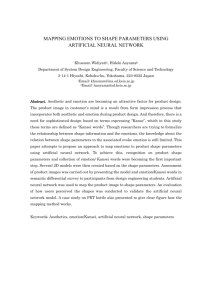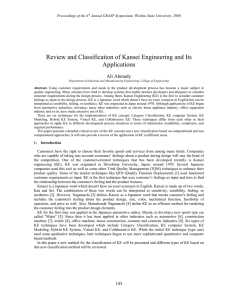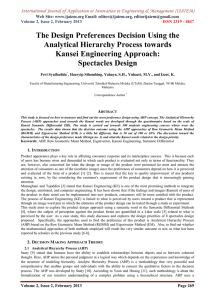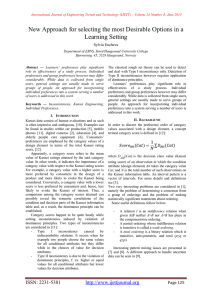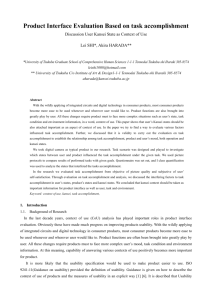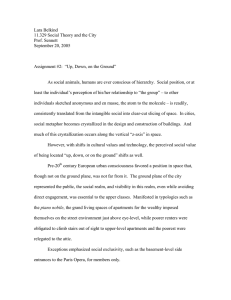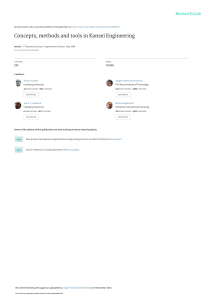Collective Views of the Workings and Significance of Experiences Z the S
advertisement
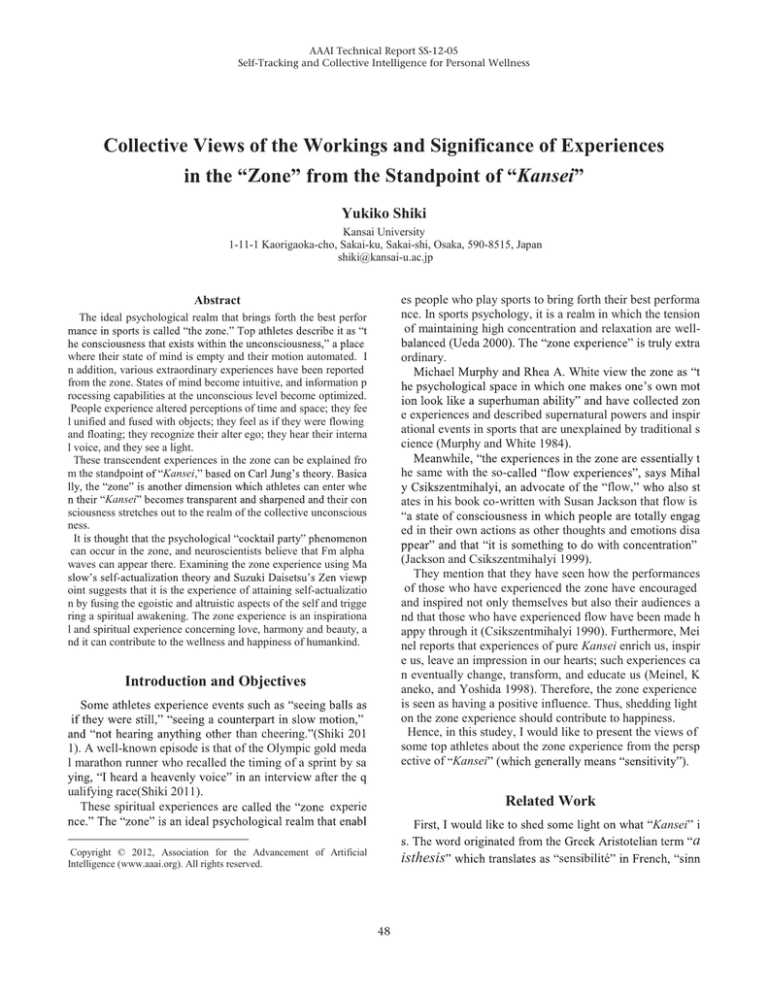
AAAI Technical Report SS-12-05 Self-Tracking and Collective Intelligence for Personal Wellness Collective Views of the Workings and Significance of Experiences Z the S Kansei Yukiko Shiki Kansai University 1-11-1 Kaorigaoka-cho, Sakai-ku, Sakai-shi, Osaka, 590-8515, Japan shiki@kansai-u.ac.jp es people who play sports to bring forth their best performa nce. In sports psychology, it is a realm in which the tension of maintaining high concentration and relaxation are well- Abstract The ideal psychological realm that brings forth the best perfor ordinary. where their state of mind is empty and their motion automated. I n addition, various extraordinary experiences have been reported from the zone. States of mind become intuitive, and information p rocessing capabilities at the unconscious level become optimized. People experience altered perceptions of time and space; they fee l unified and fused with objects; they feel as if they were flowing and floating; they recognize their alter ego; they hear their interna l voice, and they see a light. These transcendent experiences in the zone can be explained fro Kansei, m the standpoi e experiences and described supernatural powers and inspir ational events in sports that are unexplained by traditional s cience (Murphy and White 1984). he same with the so- l flow, ates in his book co-written with Susan Jackson that flow is Kansei sciousness stretches out to the realm of the collective unconscious ness. It can occur in the zone, and neuroscientists believe that Fm alpha waves can appear there. Examining the zone experience using Ma oint suggests that it is the experience of attaining self-actualizatio n by fusing the egoistic and altruistic aspects of the self and trigge ring a spiritual awakening. The zone experience is an inspirationa l and spiritual experience concerning love, harmony and beauty, a nd it can contribute to the wellness and happiness of humankind. ed in their own actions as other thoughts and emotions disa (Jackson and Csikszentmihalyi 1999). They mention that they have seen how the performances of those who have experienced the zone have encouraged and inspired not only themselves but also their audiences a nd that those who have experienced flow have been made h appy through it (Csikszentmihalyi 1990). Furthermore, Mei nel reports that experiences of pure Kansei enrich us, inspir e us, leave an impression in our hearts; such experiences ca n eventually change, transform, and educate us (Meinel, K aneko, and Yoshida 1998). Therefore, the zone experience is seen as having a positive influence. Thus, shedding light on the zone experience should contribute to happiness. Hence, in this studey, I would like to present the views of some top athletes about the zone experience from the persp ective of Kansei Introduction and Objectives than cheering. (Shiki 201 1). A well-known episode is that of the Olympic gold meda l marathon runner who recalled the timing of a sprint by sa ualifying race(Shiki 2011). These spiritual experiences Related Work experie Kansei a Copyright © 2012, Association for the Advancement of Artificial Intelligence (www.aaai.org). All rights reserved. isthesis 48 sensibilité lichkeit nglish depending on the situation. However, the meaning o f the word Kansei varies from one user to the next; it has m ultiple definitions, academic and otherwise. In addition, ma ny believe that Kansei contains subtle nuances that cannot be conveyed otherwise; thus, the word has been adopted as KANSEI 9). According to interviews with professionals and students in various fields, including top athletes, using questionnair Kansei Kansei sciously and instantly operates information processes such as receiving, assimilating, and outputting information that cannot be recognized by the normal operation of the five se nses (see Figure 1). The term Kansei involves both the phy he sharpening of the five (or six) senses in its broad meani ng (see Figure 2). It has two receiver and transceiver anten nae, and comprises sensitivity, decisions, and creation in it s structure. The main factors are sensitivity, imagination, a nd creativity. It also relates to aesthetics, sense, instinct, so ul, talent, and personality, serving as the basis for individua lity and ethics. This ideal function brings forth optimum sit uations the best performance, inspiration, a sense of unity, and the actualization of love and harmony by integrating c onsciousness and unconsciousness. , etc Kansei d their commonalities are listed in figures 1 and 2. Receiver antenna Information Research methods Transceiver antenna Processing Kansei ts events and examined its condition when best performanc es were produced by targeting top current and former athlet es between 1999 to 2001 and 2005 to 2011. The research ta rgets are sixty-three athletes, including thirty-eight males a nd twenty-five females in their late twenties to mid-fifties f rom twenty-two sports fields (such as soccer, baseball, rug by, badminton, American football, tennis, track and field s wimming, shooting, gymnastics, ski, kendo, and judo). The y are among the top-level players in the world or Japan, mo stly major leaguers, Olympic medalists, world champions, Japanese national team members, and champions of studen t competitions. Information (Sensitive aspects) (Decision aspects) (Creation aspects) The ellipses represent the consciousness equivalent to an of kansei The right side is a receiver antenna and the left side is a transceiver antenna. This represents the entire flow of kansei information. Shiki Fukubayashi 2003, reorganization Figure 1 Structure of Kansei Results The circle represents the consciousness. The central circle shows that the realm of consciousness is limited within the five senses. The outside circle shows that the consciousness is spreading toward the realm of the sixth sense. There is a sense of unity in the examined zone experienc es, for example, a playerwho achieved a world record, said There is also an alt ered perception of time, for example the world home-run re sight hearing touch taste smell sixth sense i 2008). These features are illustrated in Table 1. Consciousness Discussion An examination of the characteristics of the zone experi ence Let us examine the main categorized features from the st Kansei Unconsciousness The five senses Shiki 2003, reorganization Figure 2 The relationship between the five senses and the sixth se nse at only necessary information is selectively inputted in ord er to produce the best performance. Many examples of the Kansei based on the cu een collected, and it is assumed that the sensory input and output of information is unconsciously controlled. Informat rrent research results. 49 ion processing, from receipt to output (as shown in Figure 1), is believed to instantly operate to output through physic g sounds even though they are in fact aud Accordingly, Kansei is an internal sense that resides in both mind and body, where both are believed to be linked qi (Yuasa 1994). The research suggests that athletes, especially those in match- -cal ccurs through various senses (Shiki 2011). presumed to express the realm of as opposed to the general realm of that athletes tend to use, which is a purely visual sense. As the realm of corresponds to the consciousness that functions as the antenna of Kansei, naturally obtain more input athletes who utilize information (i.e., Kansei information) than those who use only down a ball. used by baseball players, expresses the pl The Main Features 1 Intuition Inspiration/ Visual images Alteration of Five Senses 2 3 Unconsciousness 4 Sense of Unity and Fusion 5 Recognition of Guidance 6 Inner World 7 Automation of Alteration of Time and Space 8 Positive Sense and 9 Feeling 10 Other Force Foresight and Prediction 12 Natural Flow 11 13 Holistic Sense 14 15 16 17 18 19 20 21 22 23 24 25 26 27 28 Qi or Life Energy, Wave and Aura Clearness Flip of a Switch Closed World High Concentration Altruistic Spirit Sense of being Wrapped Energy Lightness Calmness and Excitation or Recognition of Harmony Sense of Floating Detachment Playback of Memory Details Obtuseness of Visual and Hearing Senses/ Sensitivity of Visual and Tactile Senses/ Sensitivity of Time Sensation/ Silence/ Aponia/ Selective Attention that enables athletes to capture all of the players on a pitch as if viewing through a TV camera. Furthermore, the alter ego that many athletes say makes them feel as if they are looking at themselves from above suggests the ability to see events from a third-person perspective and perceive an objective ability. The zone experience is thus believed to possess an objective dimension. 59), Figure 3 shows ho w athletes enter the zone (Shiki and Fukubayashi 2001). W hen athletes are in an ordinary state of mind, their consciou sness, functioning as an antenna, lies in . When they enh ance their concentration and become unconscious, they mo Unconscious Movement/ Empty Mind/ The State of Muga (egolessness) or Enlightenment Oneness of Mind and Body/ A Sense of Unity with Teammates/ A Sense of Unity and Fusion with Tools and Equipment/ Fusion with Music/ Oneness with the audience/Oneness with all Beings/ Coinciding of Image and Reality Physical Guidance/ Guidance by an Orbit/ Guidance by Illumination and Brightness Conversation with Alter Ego/ Communication with Instructors and Teammates/ Recognition of Inner Voice and Conversation with Inner Voice/ Recognition of Inner Being Movement without Thought/ Natural Movement/ Natural Self Alteration in Time Perception/ Slow Motion/ Alteration of Size A Sense of Control/ A Feeling that Everything is in Favor/ Can-Do Attitude/ Peak-Experience Positive Influence of the Cheers of the Audience/ Positive Influence of Family's Support Sensation of Crisis Ahead/ Visual Image tion of consciousness moves toward Fluidity/ Natural Self/ Smoothness Panorama/ Perception through the Body/ Alter Ego/ Objective View ng with the surroundings and losing the sense of distinction Inference(feeling "qi")/ Sense of Wave nconsci Clearness of Mind and Body/ Clearness of the Surroundings Switch of Mind In One's Own World Transcendence of Five Senses Altruistic Feeling for Teammates n the movement from , and a state of muga, . As seen above, the condition of consciousness that athlete t exists within unconsci Protective Coat/ Full-Body Suit to Support Body/Capsule Outputting an Aura/ Sense of Transmitting the Force Weightlessness to Calmness and Excitation/ Calmness and Tension Brightness/ Illumination/ Light Harmony of Mind and Body Feeling of Floating Detachment from Victory/ So-What Attitude Flashback or Memory of Whole Life n mind is absolutely passive and a mind is generously entrust Table 1 Main features and details of the zone experience utomaton as far as c describes is in accord with the condition in which the moti on of the empty-minded athlete is automated and subject to another force. It is assumed that the Fm (theta) waves ca the brain of a medi tating priest of the Soto Buddhist sect (Shiki 2008). Another baseball player thought of Kansei the relationship between the five senses and the sixth. to represent the ordinal five senses and Figures 50 The closer it gets to , where the distinction between self nomena cannot be sensed through the ordinary five senses but only by the sharpened five senses and the sixth sense w hile the athlete is in the realm of as shown in Figure 2 a nd in the movement from to as in Figure 3. The qi s apparently gradually perceived as a whit e haze through training (Yuasa 1994). It is th gest in the condition. Just as some athletes manifest an s and equipment, it is thought that those who experience the zone go through a self- ow 1973) henomena help guide the athletes towards their best perfor mance. The central circle represents the consciousness equivalent of a kansei antenna. The symbol represents the transformation of the conscious condition. As the realm of the consciousness expands from to , the distinction between self and others disappears and the state of muga or enlightenment is attained. no harmony A consciousness unconsciousness B selfish ego Individual al cons consciousness altruistic ego distinction Consciousness nd mind that is pure and clean. As a result, the athletes felt he consciousness of the athletes lies in another dimension a nd their physical weight cannot be felt. There is a theory that qi is a kind of energy of which not only humans but all living beings are composed of (Yuasa 1994); another theory posits the human aura energy field it harmony ego+altruism selflessness no distinction A tool, nature, a partner, partne the audience etc. Expansion of the consciousness antenna of Kansei Collective unconsciousness Shiki erienced by synchronized swimmers epitomizes this energy field unding energy field. describes how the energy field of the athletes merges into other energy field so that they fl ow together. It also shows that the processes of , , and are each distinct and flow smoothly. It is believed that Fukubayashi 2003, reorganization 3 Figure 3 Structure of how to enter the zone sixth sense ry or to the record they will achieve, occurs through the ch ange of consciousness from to and through the value transformation from the physical dimension to another leve l. They become intuitive and gain inspiration because they Figure 4-1 The five senses Figure 4-2 ccumulated in the collective unconsciousness by stopping t s thought to happen when the conscious condition goes thr ough individual unconsciousness by changing the conditio to . n from Shiki 2008, reorganization Figure 4-1 and 4-2 represent the relationship between Figure 2 and 3. Figure 4-1 and 4-2 4 simplifies Figure 2 and 3 respectively. a layer close to their skin formed by an energy fieldthat is generally believed to have seven layers. the light eads athletes to victory, it is possible that athletes sensed th e presence of an archetype by enhancing their mentalities (Jung 1981). Figure 4 The relationship between Figures 2 & 3 The consciousness is aware of the physical world when in but is believed to be moving toward another dimension as it transforms from to . ness of another dimension. Figure 4 shows the relationship between figures 2 and 3. ping the secret of artistic and religious activities, you have sense qi, place and where the dynamic force of the universe light 51 Kansei into forms that ordinary people can recognize in the physic Nature and significance of the zone iousness" for B is equivalent to a in the depths of our mind. You can say that once it is awakened, the secondary nature of the mind is resolved and our mind is able to sense, into (Suzuki 1972). Since the zone experiences are believed to be related to the collective unconsciousness, it is assumed t hat the deep realms of the mind are involved. That is to say, the zone is an experience that awakens a spirituality functi oning in the depths of our minds. Athletes who enter the zone experience are overjoyed an d are filled with positive feelings. Upon entering the zone, t hey are detached from their records and their victories, de monstrating that their sense of value has been transformed from the physical world into another dimension. Suzuki mentions that another world opens behind the me ntal and physical worlds (which many people regard as bei workings of the Kansei forc Kansei force. Figure 5 has duplicated Figure 3 side-by-side, and A and B represent the conscious condition among teammates and between athletes and the audience. A A Consciousness impression light C Consciousness B Border of the self Individual consciousness B Individual consciousness deep disappearance Expansion of the consciousness antenna of Kansei unity sharing of information unconscious network The structure of sensation and a sense of unity Figure 5 presents two parallels for the item in Figure 3, s howing how a sense of unity is formed between two athlete s, A and B. When both consciousnesses approach the realm s of the collective unconsciousness, from to Collective unconsciousness Shiki be formed not only amo ng athletes but also between the athletes and the audience, when the athletes enter the zone and the audience cheers fo r them. Fukubayashi 2003, reorganization5 Figure 5 Structure of a sensation and a sense of unity The Kansei force manifests in the process of reaching th e collective unconsciousness, when the ordinary conscious ness starts removing the distinction between self and others and attaining the state of muga, or enlightenment, thus ena bling those involved to transform their consciousness into unconsciousness as well as to transform unconsciousness i nto their consciousness. At the same time, this enables thos e exposed to the performance created by the manifestation of the Kansei force to be endowed with the Kansei force an d polish their own Kansei. As represented by the fusion of egoistic and altruistic or objective and subjective natures, t he workings of the Kansei force allows a human to transce nd secondary phenomena and achieve self-actualization. A first-class performance enables us to feel that all beings are mutually connected, which is deeply involved in inspiring a sense of healing and happiness. Thus, it helps translate th e soo us in our daily lives. the referee, and the audience was in favor of me," increase hes believed to be experienced through the collective unconsciousness. The precondition for these relationships with all things is t Taking A as the mind of an athlete and B as that of the a ective unconsciousness is elevated to the conscious level a ciousness [is] transformed int ssion. At the same time, this enables B to sense the Kansei information that cannot be recognized through the five sens es in the unconscious realm while receiving clues from the physical expressions that can be sensed through the five se K ansei force itself. a human being is being amorphous. Nothing should be don e other than manifesting its morphology through a noble de Kansei informatio 52 References Brennan, B.A. 1987. Hands of Light: A Guide to Healing Throug h the Human Energy Field New York:Bantam Books. Kansei. Csikszentmihalyi, M. 1990. Flow: The Psychology of Optimal Ex perience, New York:HarperCollins e-books The future vision If we Jung, C.C. 1959. The Archetypes and the Collective Unconscious New York:Bollingen Foundation by Pantheon Books The sense of unity by which athletes and audience in the Kansei of Those who experience the zo ne and the audience electrified by their performance can ac tually feel interconnected with all beings through the collec Kansei. In other words, to be exposed to the zone of human beings evokes t Kansei Kansei. This d epth of sensation creating a strong impression corresponds to the level of Kansei manifested by the individual who pro duces the performance. In general, it is said to be important to be exposed to hig h-end material in order to polish Kansei because high-end Kansei, which easily enters the zone, exhibits high-power Kansei. Therefore, it is thought that being exposed to a perf ormance in the zone and feeling the resulting sensations lea ds to well-being in a broad sense. flow improves the quality of lif Goethe, Johann Wolfgang von; Junsuke Fukita trans. 1947. Goeth e Quotes, Vol. 2, Tokyo:Natsume Shoten Maslow, A. H., 1973. The Farther Reaches of Human Nature. Ne w York:Viking Press. Murphy, M. and White, A. R., 1978. The Psychic Side of Sports. Reading, Mass. : Addison-Wesley. Meinel, K.; Kaneko Akitomo trans. 1998. Ästhetik der Bewegung.. Tokyo:Taisyukan Shoten. Nagasawa, S. 1999. Kansei Engineering and Business, Kansei En gineering What is Kansei Engineering? The Academic Field and the Framework 1: 37-47 Shiki, Y. 2008. Discussion with Director Takeshi Okada on Sport s and Kansei Tokyo:Nihon Keizai Shinbun Shuppansha Shiki, Y.; and Fukubayashi, T. 2001. Mystic Experiences of the T op Athletes: From the Best Performances Circumstances. Researc h on Kansei Engineering 1(2): 37-46, ehensively for human beings. The sense of value gained in the zone may be contributing to the spiritual health of hum an beings. Suzuki says that the so- Shiki, Y. 2003. Psychological Attribution of Elite Junior Soccer P layers: Approach to the Research on Kansei of the Athletes. Ph.D. diss., Graduate School of Human Sciences, Waseda University. we transcend the limitations established by the various sci ences that conduct analytical research on the human consci ousness (Suzuki 1964). In the future, academic research tha t integrates the viewpoints of neuroscience, zen or yuishiki as analyses of the zone experience will be beneficial for th e wellness and happiness of all humankind. Suzuki, D. 1964. Zen and Japanese Culture, Tokyo:Iwanami Shot en. Suzuki, D. 1972. Japanese Spirituality, Tokyo:Iwanami Shoten. Takazawa, N. 2000. Sports Psychology Handbook. Masao Ueda e d. Tokyo:Jitsumu Kyoiku Shuppansha. Shiki, Y. 2011.Why is sensation produced? -Secret of Sports Kansei -, What is health for modan people: Takeuchi, Y,Sugimo to,A., Nishiyama,T.,Morishita, S., and Kaneko, E. eds . Kyoto:Sh oshi Kurarute:134-146 Conclusion The zone experience, a kind of a Kansei experience, sym bolizes the spiritual arousal of human beings and represent s an opportunity to stimulate spiritual development and tra n Yuasa, Y. ed. 1994. Comprehensive Dictionary of Qi, Tokyo:Shin jinbutsu Orai Sha. Acknowledgements This work was carried out with the cooperation of many top ath letes and coaches. Iwould like to acknowledge their contribution a nd the great support of my teacher, Dr. Toru Fukubayashi in Was eda University. I also thank AAAI for granting me this wonderful opportunity. 53
